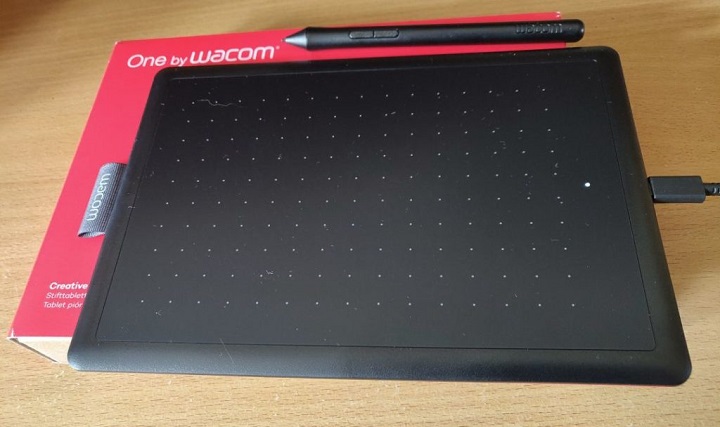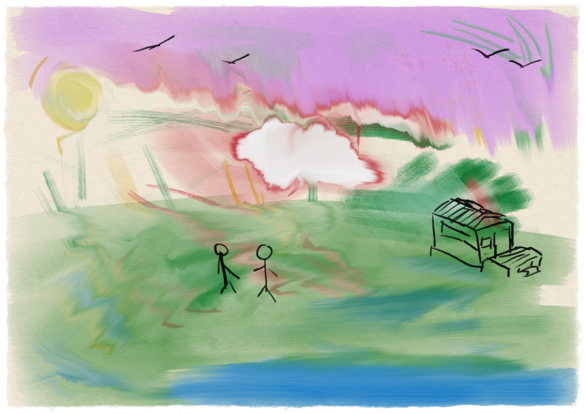One by Wacom Review: An affordable pen tablet for Starters

Graphics tablets have long been considered professional tools for illustrators, image editors, artists and designers who need an intuitive, almost classic input device for their creativity.
In recent years, more affordable products have somewhat adjusted this assessment; and not least the current challenges of distance learning make drawing tablets interesting for pupils, students and teachers as well.
one By Wacom is a good beginner drawing tablet to start on, especially since it was the most affordable Wacom tablet.
In this review, I'm going to share with you my experience using One by Wacom. I have no previous experience with drawing tablets, so wasn't quite sure what to expect.
First Impressions
The One by Wacom is the basic spec gadget, and not comes with a built-in display. Don't to be confused with the Wacom One 13-inch pen display, a totally different tablet.
The tablet is made entirely of plastic and can be bent a bit, but it doesn’t take any damage in the process. I also let it crash from my desk onto the laminate floor a few times without it quitting or even breaking.
It's roughly the size of an A5 sheet of paper, which features an 8.5 x 5.3" active area that allows you to draw, make handwritten notes, and interact with compatible computer applications as though you were using a pen and paper.
The tablet itself just requires a USB connection, but the supplied USB cable was a bit on the short side, but as it uses standard connections, I can just get a replacement if it becomes to difficult to use.
The included stylus has up to 2048 levels of pressure sensitivity, so you can press harder for thick lines and softer for light ones. It also uses electromagnetic resonance technology, so you never have to worry about changing the pen's batteries or keeping it charged.
The pen fits quite well in the hand and is slightly wider towards the tip to provide additional support for the index finger. It has 2 configurable buttons and includes two additional nibs.
Install driver
Installing drivers from the Wacom website is pretty painless. I'm a bit disappointed that they don't seem to offer drivers for Linux. Just Windows and Mac. I guess I won't be able to use this tablet with my Linux laptop.
Windows 11 needs a restart and once that's done, I can instantly start using the tablet. Windows also helpfully enables its Ink API without any difficult configuration needed.
When first using the tablet, I'm a bit unsure of how much I'm supposed to be pressing on it. I've turned the sensitivity all the way down for now, which seems to go quite high, so I guess I can press a lot harder. But as this is a new toy to play with, a thin one at that, I'm a little nervous of breaking or scratching it right off the bat. I think I'll jut deal with low sensitivity for now and see how that goes.
The first program I tried using it was with the Microsoft whiteboard app, which the Ink API suggests installing. There's also OneNote (Desktop and Windows app flavours). They both work very well. So you can use it as a pen tablet for note taking.
If you are using a Chromebook, just plug the tablet to your USB port and you have an instant start. No driver installation required. It couldn't be easier. It is one of the most affordable drawing pads for chromebook.
Drawing Experience
For testing actual, decent drawing, I have a bit of a problem – I cannot draw. My sense of proportion, shape, colour, whatever are all completely non-functional. That's why I wanted to get this tablet – to help me learn.
My main drawing software of choice is Krita, and it seems to play well with the pen input, which has pressure sensitivity support. It has a decent quick selection menu on right click, but I need to practice a lot more to be able to use it to its fullest capabilities.
I'm finding it difficult to determine the correct posture to draw curves and straight lines. Everything I draw ends up quite wonky unless I really focus on small movements – which I don't want to do because I can imagine that leading to RSI over time.
When drawing, the tablet has quite a nice surface texture. It's not too resistant and quite smooth to glide the pen across. i have noticed that in some cases the pen nib seems to “click” oddly, I'm not sure what I'm doing wrong there. It's as if it's catching on something as it moved up and down slightly when I press it in certain ways.
Drawn using a Wacom One tablet and Krita:

The tablet can also act as a substitute pointing device for a mouse. That works reasonably well but there are some applications where buttons don't press properly, and trying to drag invokes scrolling instead. I suspect these are more likely limitations of the OS or applications than the driver or device.
The tablet has a little blinky light on it which flickers when I hold the pen over it. I don't know what that does or how I'm supposed to interact with it.
It's really going to require a lot of practice to figure out the correct way to use it, and learn how to draw. My immediate next steps are just to keep using it and getting used to it, maybe trying it out with some point & click adventure games – it seems an ideal drawing tablet for Osu gameplay.
Conclusion
The Wacom One is an entry level drawing tablet, but seems like really good value for money. It is really easy to set up and get started with, and (though I'm no expert) I'd recommend it for anyone else looking to get started with this kind of tech.
No matter if you want to work in creative apps or looking for a tool that enables you to write, annotate or doodle shapes in educational software. This tablet has everything you need, so it's easy to get started on your next project or lesson.
